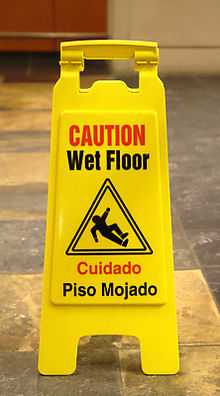Wet floor sign
A wet floor sign is used to warn people about wet floors and so prevent them from slipping and falling.[1][2] Businesses often place such warnings to avoid negligence charges brought by people on their property. In many countries, if an injury results from a wet floor, the owner of the premises may be found liable for compensatory damages. Many lawyers specialize in such tort lawsuits. Sometimes wet floor signs are not enough.[3] Effectiveness in modifying behavior has been shown to be enhanced when a wet floor warning is also presented aurally every 10 seconds by a tape player.[4] Robotic cleaning equipment can use wet floor signs to know when its job is finished via sonar.[5]
Liability under United States common law
By the calculus of negligence, placing these signs makes sense even if there is a very small chance of anyone slipping. One factor in determining liability is the awareness of the landowner of the spill. Because individuals are generally expected to be less aware than businesses are of incidents such as spills, wet-floor signs are not usually found on personal property such as family dwellings. Nevertheless, a house guest can seek injury compensation, alleging liability for the tort of negligence. The highest standard of liability exists in the workplace, where workers' compensation may apply to any injury regardless of fault. The lowest standard exists for uninvited trespassers; some jurisdictions do recognize a duty to warn anticipated or unanticipated trespassers.[6] A "wet floor" sign placed at the entrance to a store, combined with periodic mopping of the entrance area during rainy periods to prevent an unreasonable accumulation of rain water, constitutes reasonable and ordinary care on the proprietor's part.[7]
See also
| Wikimedia Commons has media related to Wet floor signs. |
References
- ↑ Steven Di Pilla. Slip and Fall Prevention: A Practical Handbook. CRC Press. ISBN 1-56670-659-9.
- ↑ "Patent US7013590 - Floor sign - Google Patents". Google.com. Retrieved 2013-07-06.
- ↑ RJ Kendzior (2002), When 'wet floor' signs aren't enough, Occupational Health & Safety
- ↑ MS Wogalter, SL Young (1991), Behavioural compliance to voice and print warnings, Ergonomics
- ↑ Larson, Jan (1998). "RoboKent - a case study in man-machine interfaces". Industrial Robot: An International Journal 25 (2): 95–100. doi:10.1108/01439919810204577. ISSN 0143-991X. Retrieved 2013-03-03.
- ↑ See Trespasser#Duties to trespassers. WIkipedia
- ↑ Adams v. Winn-Dixie Stores, Inc., 386 686 (Ga: Court of Appeals 1989).
